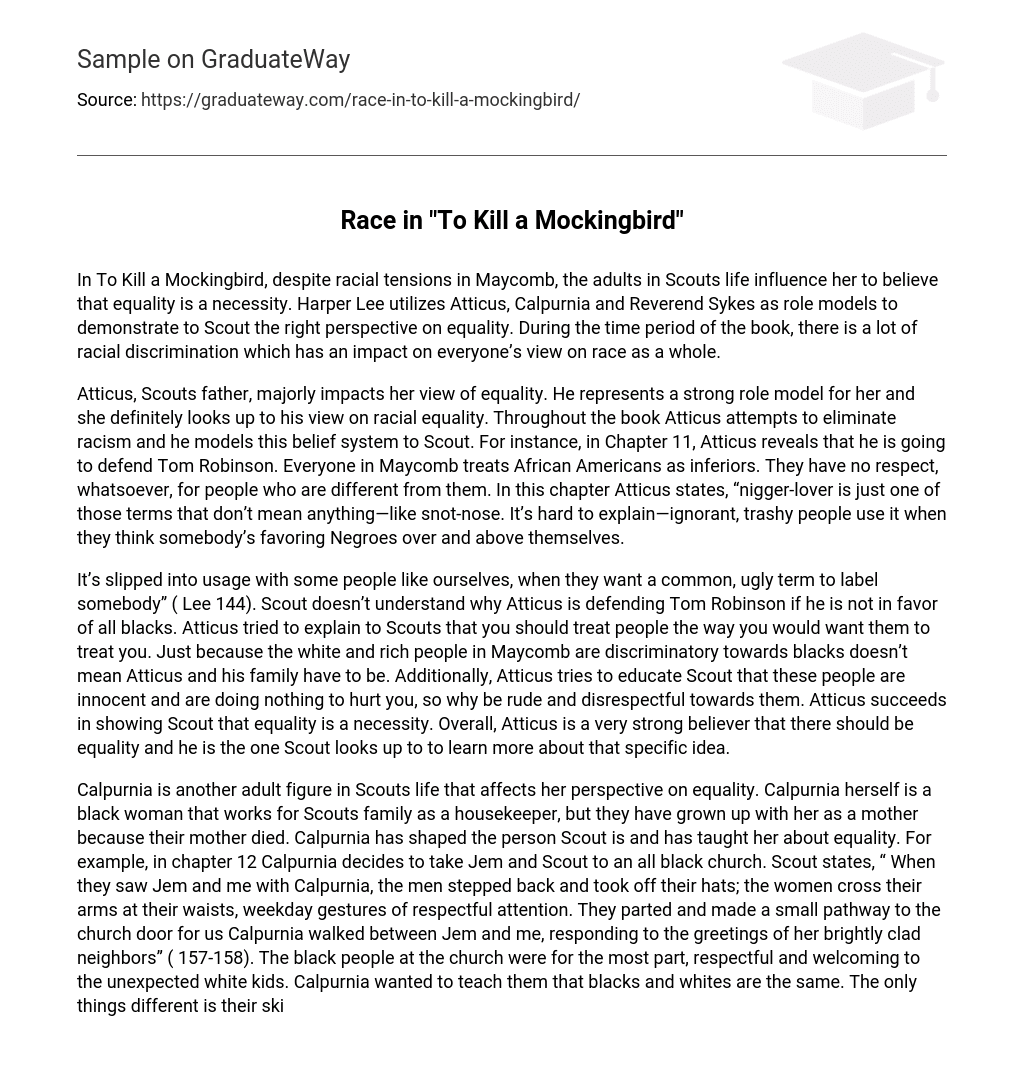In To Kill a Mockingbird, despite racial tensions in Maycomb, the adults in Scouts life influence her to believe that equality is a necessity. Harper Lee utilizes Atticus, Calpurnia and Reverend Sykes as role models to demonstrate to Scout the right perspective on equality. During the time period of the book, there is a lot of racial discrimination which has an impact on everyone’s view on race as a whole.
Atticus, Scouts father, majorly impacts her view of equality. He represents a strong role model for her and she definitely looks up to his view on racial equality. Throughout the book Atticus attempts to eliminate racism and he models this belief system to Scout. For instance, in Chapter 11, Atticus reveals that he is going to defend Tom Robinson. Everyone in Maycomb treats African Americans as inferiors. They have no respect, whatsoever, for people who are different from them. In this chapter Atticus states, “nigger-lover is just one of those terms that don’t mean anything—like snot-nose. It’s hard to explain—ignorant, trashy people use it when they think somebody’s favoring Negroes over and above themselves.
It’s slipped into usage with some people like ourselves, when they want a common, ugly term to label somebody” ( Lee 144). Scout doesn’t understand why Atticus is defending Tom Robinson if he is not in favor of all blacks. Atticus tried to explain to Scouts that you should treat people the way you would want them to treat you. Just because the white and rich people in Maycomb are discriminatory towards blacks doesn’t mean Atticus and his family have to be. Additionally, Atticus tries to educate Scout that these people are innocent and are doing nothing to hurt you, so why be rude and disrespectful towards them. Atticus succeeds in showing Scout that equality is a necessity. Overall, Atticus is a very strong believer that there should be equality and he is the one Scout looks up to to learn more about that specific idea.
Calpurnia is another adult figure in Scouts life that affects her perspective on equality. Calpurnia herself is a black woman that works for Scouts family as a housekeeper, but they have grown up with her as a mother because their mother died. Calpurnia has shaped the person Scout is and has taught her about equality. For example, in chapter 12 Calpurnia decides to take Jem and Scout to an all black church. Scout states, “ When they saw Jem and me with Calpurnia, the men stepped back and took off their hats; the women cross their arms at their waists, weekday gestures of respectful attention. They parted and made a small pathway to the church door for us Calpurnia walked between Jem and me, responding to the greetings of her brightly clad neighbors” ( 157-158). The black people at the church were for the most part, respectful and welcoming to the unexpected white kids. Calpurnia wanted to teach them that blacks and whites are the same. The only things different is their skin color. They can still be polite and kind to others, so why should whites not be the same back. Scout also realized that the black people in that community were appreciative, even more than the people in Maycomb, because Atticus was defending a man just like them, Tom Robinson. Calpurnia did her job as a mother figure to present the African american society to Scout and show her that they are the same humans and there should be equality no matter what.
Reverend Sykes is the last and final adult figure in Scouts life that influences her opinions on equality. During Tom Robinson’s trial Reverend sat with Scout and Jem in the balcony, with all the other African American people, helping to explain any confusions that the kids had about the trail while it was going on. Reverend was also a source of protection during that trial. Reverend was part of Calpurnia’s community, part of the all black church, he was a very generous person. He always felt the need to help people, he even made sure to raise money for Tom Robinson’s mom and family during this time.
For instance, in chapter 21 Reverend Sykes uttered to Scout, “ Miss Jean Louise, stand up. Your father’s passin’ “ ( 283). In the courthouse room at that moment, all of the African Americans were standing up for Atticus walking out of the trial after his closing statement. This was as a sign of respect because as a man, who lives in a very discriminatory and white community, he defended a man of different race. Scout saw how many blacks were showing respect to a white man because they were appreciative of Atticus’s service. Reverend demonstrated to Scout that black people can be very thankful and admiring to whites, so why not join them in this service. Scout realized that equality is required to unify people and admire people’s actions that impact others, whether you are black or white. Overall, Reverend Sykes was fortunate to help determine Scouts views on equality.





